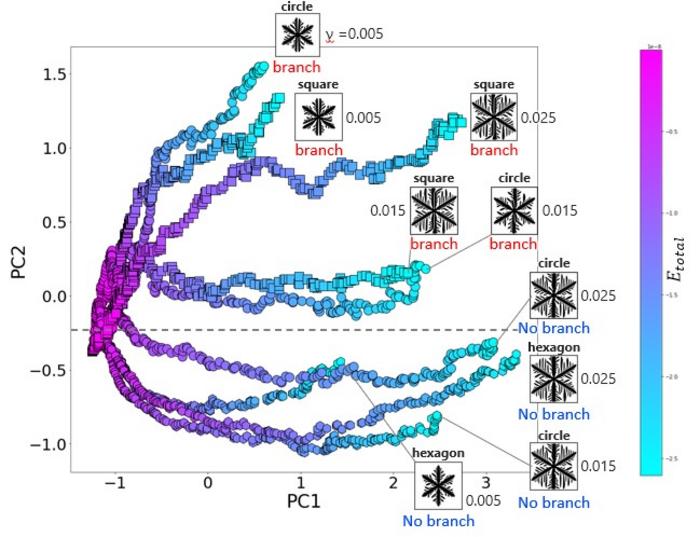In a breakthrough study that holds significant implications for the future of material science, researchers from Tokyo University of Science have developed an innovative artificial intelligence (AI) framework that combines persistent homology with energy analysis to gain valuable insights into dendritic growth in thin film materials. This research, spearheaded by Professor Masato Kotsugi and his team, opens new avenues for understanding and optimizing the complex processes that define the microstructures of materials crucial for next-generation technologies, including high-speed communications systems.
Thin films, which consist of layers of materials just a few nanometers thick, are integral to various technologies, from semiconductors to advanced communication systems. Despite their potential, dendritic structures, which are characterized by tree-like branching patterns, present significant challenges for the fabrication of larger-area thin-film devices. Dendrites form during the growth phase of materials like copper and graphene, particularly during multilayer deposition, and their presence can adversely affect device performance. Understanding the mechanisms behind dendritic branching could lead to improved thin-film fabrication practices, but until now, the analysis of these structures largely relied on subjective visual interpretations.
To tackle these issues, Kotsugi and his team leveraged cutting-edge techniques to create a new analysis model that complements traditional methods. The integration of persistent homology—a topology-based method that allows for the multiscale analysis of geometric features—enables a more nuanced understanding of the structures formed during thin-film growth. Persistent homology captures complex topological features of dendritic microstructures that conventional image-processing techniques often miss, thereby introducing a significant shift in how researchers can interpret these intricate formations.
Moreover, the researchers have combined persistent homology with principal component analysis (PCA), a well-accepted machine learning technique widely used for dimensionality reduction. By applying PCA, the team effectively transformed the complex data derived from the topological analysis into a two-dimensional representation. This approach allowed them to quantify the structural changes in dendrites and establish a correlation with Gibbs free energy. Gibbs free energy is critical in material science as it determines the potential for growth patterns during crystallization, influencing how and why dendrites branch out.
This novel integration of topological analysis and machine learning not only sheds light on the mechanisms driving dendritic growth but also offers a consolidated framework for optimizing the conditions under which thin films are produced. By mapping dendritic morphology to variations in Gibbs free energy, the researchers were able to reveal the underlying energy gradients responsible for dictating branching behaviors during crystal growth. Their findings represent a substantial advance in material science, providing a data-driven pathway for the creation of high-performance thin films that could facilitate communication technologies beyond current fifth-generation (5G) systems.
Moreover, the researchers validated their method by conducting experiments on dendrite growth in hexagonal copper substrates. The empirical results were compared against data sourced from phase-field simulations, confirming the reliability of their AI-guided model. The implications of this research extend far beyond the immediate concerns of dendritic growth; the framework they have developed could serve as a robust tool for exploring numerous facets of material science, as it connects atomic-level microstructures to their macroscopic functionalities.
The significance of this study lies not only in its innovative approach but also in its potential to propel advances across various applications. Insights derived from analyzing dendritic structures could have far-reaching implications for sensor technologies, nonequilibrium physics, and the development of high-performance materials. Moreover, the focus on establishing comprehensive relationships between hidden structural features and functional performances could form the foundation of future interdisciplinary research aimed at optimizing materials for a range of high-tech applications.
Professor Kotsugi emphasizes that their method could lead to the creation of high-quality thin films essential for industrial advancements that rely heavily on rapid data transmission and processing capabilities. The research published in the journal "Science and Technology of Advanced Materials: Methods" encapsulates a forward-thinking ethos that resonates within the scientific community. The pressing need for innovative approaches to material analysis is evident, given the fast-paced advancements in technology and the complexity of modern materials.
The research team at Tokyo University of Science has positioned itself at the forefront of material science by marrying traditional techniques with modern computational power. This strategy serves to address the innate challenges associated with understanding complex material systems. By capturing essential structural features and correlating them with thermodynamic principles, this research demonstrates a commitment to quality and innovation in material development.
As we look toward the future, it is evident that this confluence of cutting-edge research, topological techniques, and AI capabilities will not only enhance our understanding of dendritic structures but could ultimately revolutionize the way we approach materials science. The research provides invaluable insights into harnessing the complexities of material formation processes, setting a new paradigm for researchers and engineers alike who are striving to push the boundaries of what is currently achievable in high-tech industries.
The future of thin films and high-performance materials now appears brighter as innovative methodologies like those developed by Kotsugi and his team become part of the material science lexicon. By exploring the intricate relationships between structure, growth processes, and energy dynamics, they have laid the groundwork for significant advancements in technology, potential applications that could change how we communicate, and perhaps even how we interact with the world around us.
Subject of Research: Dendritic growth in thin film materials
Article Title: Linking structure and process in dendritic growth using persistent homology with energy analysis
News Publication Date: March 7, 2025
Web References: Science and Technology of Advanced Materials: Methods
References: Kotsugi, M., Tone, M., Obayashi, I.; DOI: 10.1080/27660400.2025.2475735
Image Credits: Masato Kotsugi from Tokyo University of Science, Japan
Keywords: Dendritic growth, thin films, material science, persistent homology, principal component analysis, Gibbs free energy, high-speed communications, crystal growth, artificial intelligence, topology in materials.




